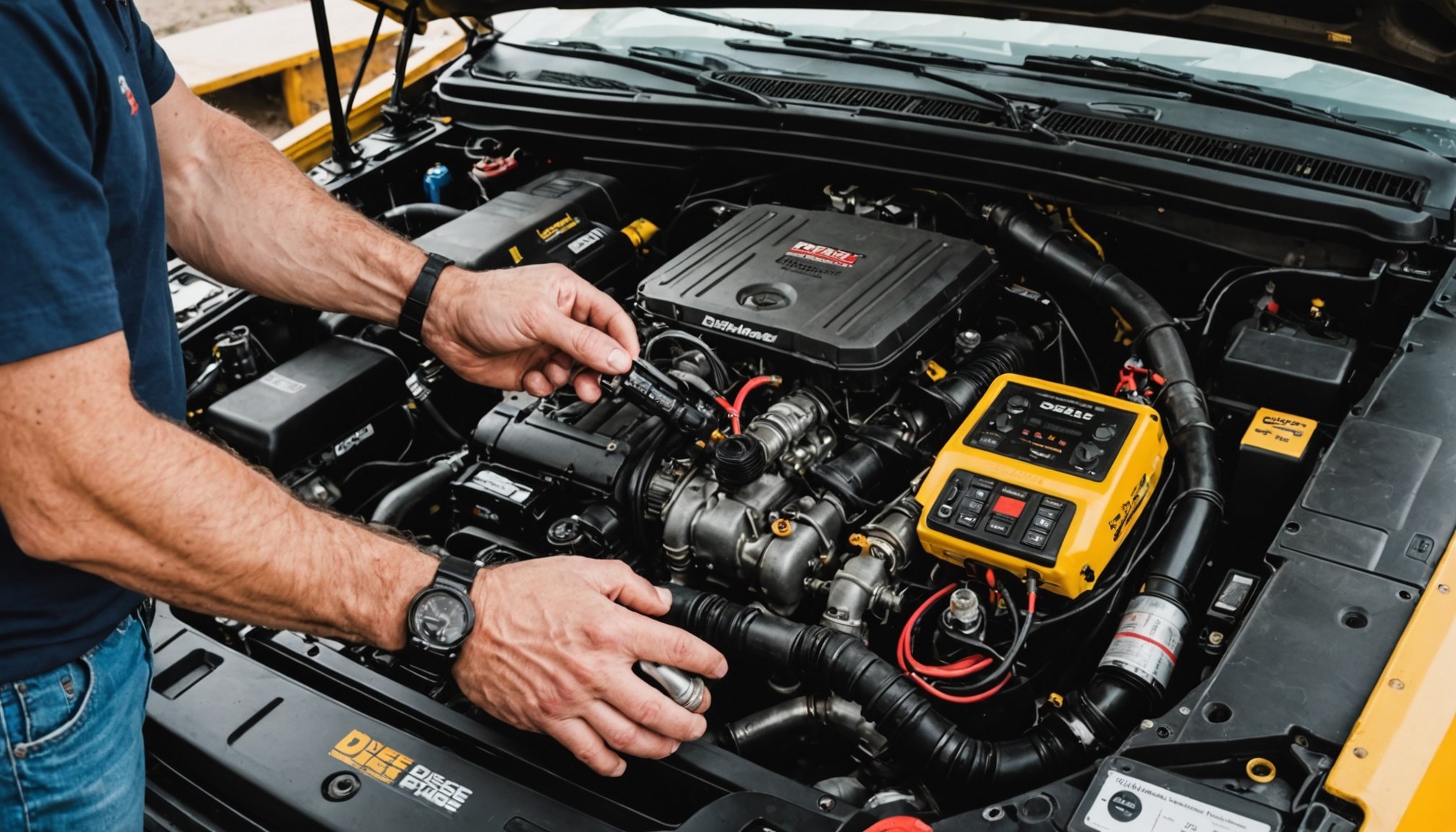Understanding Diesel Engine Start-Up Challenges
Starting a diesel engine can present several challenges due to various factors that can affect its performance. Understanding these common issues is crucial for effective troubleshooting and ensuring reliable operation.
Common Reasons for Diesel Engine Failures
Diesel engines might fail to start due to issues like fuel contamination, insufficient compression, or faulty glow plugs. Fuel contamination often results from water or debris mixing with the diesel, leading to poor ignition. Insufficient compression, typically from worn piston rings or valves, can prevent an engine from achieving the necessary conditions for ignition. Faulty glow plugs, vital in cold starting, can fail due to wear or electrical issues.
Also read : Ultimate handbook: key strategies for maintaining your vehicle”s turbocharger system effectively
Signs Indicating Potential Starting Problems
Indications of starting problems include a sluggish engine turnover, excessive smoke from the exhaust, or strange noises during ignition. Pay attention to these symptoms as they often precede more serious mechanical failures.
Importance of Recognizing Environmental Factors
Environmental conditions such as low temperatures or high humidity can exacerbate diesel starting issues, affecting the diesel performance significantly. Cold weather can thicken diesel fuel, while humidity may lead to increased condensation in the fuel system. Recognizing these influences allows for proactive troubleshooting by selecting the appropriate measures, such as using winter-grade diesel or installing heaters.
Topic to read : Mastering tire pressure for sports cars on uk’s rainy roads: a comprehensive expert guide
Essential Tools and Equipment for Jump-Starting
Understanding the essential jump-starting tools and equipment is crucial for any diesel engine owner. A successful start requires having the right diesel engine accessories on hand to tackle unexpected challenges.
Necessary Tools
To jump-start a diesel engine, you’ll need cables robust enough to handle high current, often thicker than those used for petrol engines. A reliable jumper box can provide an independent power source, eliminating the need for another vehicle. Quality matters—invest in tools that are durable and designed for diesel use, ensuring safety and efficiency. Wear appropriate safety gear such as gloves and goggles to protect yourself during the procedure.
Setting Up Your Workspace
Arranging a safe workspace is essential. Ensure the area is flat and free from flammable materials. Adequate lighting is key to avoiding mishaps. Consider using a rubber mat to prevent static electricity. These best practices help create a hazard-free environment, allowing you to focus on the task at hand.
Additional Accessories
Optional accessories can simplify troubleshooting. A multimeter helps diagnose battery issues, while a portable charger can be convenient for frequent travellers. These auxiliary tools enhance your diesel engine troubleshooting efforts, making the jump-starting process more efficient and less stressful.
Step-by-Step Guide to Jump-Start a Diesel Engine
Embarking on a jump-starting procedure for a diesel engine can be intimidating, but understanding the right approach makes it manageable. Here’s a concise, step-by-step guide.
1. Safety First
Ensure both vehicles are turned off. Put on safety gear, like gloves and goggles, to safeguard yourself against potential hazards. Position vehicles close enough for the cables to reach, without touching.
2. Connecting the Cables
First, attach a red clamp to the positive terminal of the dead battery. Connect the other end of the red cable to the positive terminal of the live battery. Next, attach a black clamp to the negative terminal of the live battery. Lastly, connect the remaining black clamp to an unpainted metal surface on the engine block of the dead vehicle.
3. Starting the Vehicles
Start the assisting vehicle first and let it run for a few minutes. Then, attempt to start the diesel engine. If it doesn’t start immediately, wait a minute and try again. Avoid repeated attempts.
4. Disconnection and Final Checks
Once started, carefully remove the clamps in reverse order. Allow the engine to run for a while to recharge the battery. Always ensure everything is secure before driving away. This detailed sequence simplifies what might otherwise be a daunting task, ensuring a smooth and safe operation.
Common Issues and Their Solutions
Effective diesel engine troubleshooting is essential for resolving various starting problems. Let’s explore common issues and their practical solutions.
Battery and Connection Issues
Diesel engine starting issues often begin with the battery or connections. A weak battery can hinder the starting process. Testing the battery’s voltage using a multimeter provides insight into its health. A reading below 12 volts indicates it’s time for a replacement. Corroded terminals can also disrupt the power flow. Cleaning them with a mixture of baking soda and water ensures optimal conductivity. Additionally, verifying secure cable connections is critical. Loose connections should be tightened to prevent intermittent power interruptions.
Fuel Supply Problems
Fuel-related issues are another frequent culprit. Blocked fuel filters can restrict flow, making it difficult for the engine to start. Inspect the fuel filter for clogs and consider replacing it regularly. Water contamination in diesel can lead to starting problems, especially in cold climates. Adding a fuel stabiliser or using water-separating additives helps maintain fuel quality.
Electrical System Challenges
Finally, electrical failures in diesel engines can obstruct starting. Faulty sensors or burnt-out fuses can be problematic. Inspecting and replacing damaged electrical components is vital. If glow plugs are worn or malfunctioning, replacing them can improve cold starts. Proper maintenance of the electrical system ensures a quicker, reliable start.
Safety Precautions When Jump-Starting
Jump-start safety is paramount to avoid accidents and ensure a smooth, successful procedure. Let’s explore the essential precautions to take.
Essential Safety Measures
When dealing with a diesel engine, special considerations are crucial. First, inspect all jump-starting tools for damage—frayed cables can lead to dangerous sparks. Ensure your diesel engine accessories are up to standard; quality components reduce risk. Always stand clear of moving parts to avoid injury during engine start-up.
Personal Protective Equipment (PPE)
Appropriate PPE is vital. Wearing gloves protects your hands from electrical shock or burns, while goggles shield your eyes from potential acid splashes. Even with high-quality diesel engine accessories, accidents can occur if safety gear is neglected.
Handling Batteries and Electrical Components
Proper handling of batteries requires caution. Connect cables following the manufacturer’s instructions: red to positive and black to negative. Deviations can result in short circuits. Monitor the battery for swellings or leaks, indicating potential malfunctions. Never lean over the battery while connecting or disconnecting cables—acid leaks are hazardous. Safety extends beyond personal protection to include environmental awareness. Ensure the workspace is dry, as wet conditions increase the risk of electrical incidents. Implementing these diesel engine precautions ensures both personal and equipment safety.
Frequently Asked Questions About Diesel Engine Start-Up
Addressing common questions about diesel engine start-up can illuminate frequently encountered challenges and solutions. Providing clarity helps users approach these situations with confidence.
General Jump-Starting Concerns
For many, the process of jump-starting a diesel engine can be daunting. A frequent question is: “Can any jump-starting tools be used?” Precision answer: While tools designed for petrol engines might work, it is safer to use purpose-built diesel engine accessories with higher amperage. Adhering to this ensures safety and effectiveness.
Another concern involves positioning vehicles correctly. Ensure both vehicles are off, with engines positioned closely but not touching. This simple setup prevents cable slack and ensures stable connections.
Advanced Troubleshooting Questions
Users often query complex starting issues like persistent failures despite working batteries. Precision answer: This may point to deeper diesel engine troubleshooting needs, such as faulty sensor replacement. Addressing such aspects demands more advanced knowledge of the electrical system, often warranting professional guidance.
Vehicle-Specific Considerations
Differences in engine models raise questions about unique jump-starting procedures. For example, certain manufacturers might recommend specific warm-up times or pre-heating steps for the glow plugs. Always refer to the manufacturer’s manual for tailored guidance and ensure you’re informed on these subtleties, enhancing diesel engine performance and lifespan.











